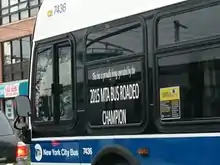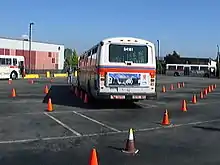International Bus Roadeo
The International Bus Roadeo is an annual bus driving and bus maintenance competition, or roadeo, hosted by the American Public Transportation Association.[1] A grand prize is given to the bus transit system with the highest composite bus operation and bus maintenance score.[2] The bus driving competition consists of an obstacle course.[3] For the bus maintenance competition, teams of mechanics must locate and fix defects in a number of bus power trains and other systems.


The International Bus Roadeo is the final competition in a system of qualifying roadeos held at the regional, state, and district levels. Bus operators from across North American are represented at the roadeo.[4] For instance, the Corpus Christi Regional Transit Authority Roadeo winners go on to a state competition in Waco.[5] The winners of each regional or state roadeo go on to represent their region at the international roadeo.[6]
The 2016 International Bus Roadeo was held in Charlotte, North Carolina in May.[7]
History
The name "roadeo" is derived from the rodeo competition.[8] The original roadeos, which began in 1937,[8] featured trucks in various categories going through the same obstacles that the bus drivers go through in the current roadeo.[9]
The first International Bus Roadeo was held in 1976.[10] Regional competitions below the international one have been held since at least 1982.[11]
Competition
Each transit system is allowed to compete in the bus operation competition (the "operators' roadeo"), the bus maintenance competition (the "technicians' roadeo"), or both.[12]
Pre-trip inspection
On the day before the competition, the bus operators are required to inspect an inspection bus and find eight planted mechanical defects, as well as one planted security-related defect. The mechanical defects can appear in areas such as flooring and seats; the security-related defect may consist of an "abandoned" briefcase or package.[12]
Bus operation
Bus operators must drive their buses through a course containing various obstacles while under a strict time limit:[12]
- In the serpentine, the bus must be driven in and out of three cones spaced closer together than the length of the bus.
- In the offset street, the bus must complete a simulated "lane change".
- In the rear duals clearance, the bus must carefully drive through a narrowing lane that is only three inches wider than the bus at its end.
- In the right hand turn, the bus must turn right while the near rear tire of the bus passes within six inches of the corner.
- In the customer stop, the bus must stop within inches of a simulated curb.
- In the reverse, the bus must reverse with the rear bumper coming within three feet of a cone behind the bus.
- In the left hand turn, the bus must turn left without hitting any cones placed close to the bus's path.
- In the diminishing clearance obstacle, the clear audience favorite during at least one regional,[13] the bus must maintain a minimum speed while driving through a narrowing path outlined by cones.
- In the judgment stop, which is the last obstacle in the course, the bus must stop less than six inches from a cone placed on the finish line.
As drivers negotiate the obstacle course, their buses are equipped with a device that generates a "smoothness of operation" score.[12] Awards are given in the thirty-five-foot bus and forty-foot-bus categories.[14]
Bus maintenance
Bus maintenance teams usually consist of three employees from a transit system. In the technicians' roadeo, technicians must diagnose and repair various mechanical issues with buses. The roadeo consists of a number of portions:[12]
- A written test, with questions on topics such as HVAC, transmission, and brakes;
- A vehicle inspection of a bus with 14 planted defects;
- Two power train events involving inspection of a bus power train with seven planted defects, and correction of a single defect that prevents correct operation of the power train;
- One air brake system event involving inspection of an air brake system with six planted defects;
- One HVAC event involving inspection of a HVAC system with a single planted defect;
- One electrical control system event; and
- One vapor door event, involving inspection of a half-height air door system mockup with seven planted defects.
References
- "What Makes a Great Bus Driver, According to the World's Best". CityLab. Retrieved 17 March 2016.
- "About the Roadeo". www.apta.com. Retrieved 17 March 2016.
- "Q&A with Howard Yoder, COTA Bus Operator". Columbus Monthly. Retrieved 17 March 2016.
- "San Mateo County CA: SamTrans Roadeo Winners Heading to International Competition Next Year". San Bruno, CA Patch. Retrieved 29 March 2016.
- Flores, Caroline. "CCRTA hosts their annual Bus Roadeo". www.kristv.com. Retrieved 29 March 2016.
- "Edmonton Transit Bus Roadeo puts drivers to the test". Edmonton Sun. Retrieved 29 March 2016.
- Cohen, Emily. "SEPTA king of the 'roadeo' bound for international bus-driving competition [video] — NewsWorks". Newsworks.org. Retrieved 30 March 2016.
- Dempewolff, Richard F. (March 1950). "Tires". Popular Mechanics. pp. 107–111. Retrieved 29 March 2016 – via Google Books.
- Kilpatrick, Bill (November 1976). "Big-rig wranglers show their tender touch". Popular Mechanics. pp. 170–172. Retrieved 29 March 2016 – via Google Books.
- "Metro History" (PDF). Washington Metropolitan Area Transit Authority. Archived from the original (PDF) on 15 October 2012. Retrieved 29 March 2016.
- "Tulsa Transit Drivers Compete in "Bus Roadeo'". NewsOK.com. Retrieved 29 March 2016.
- "2016 International Bus Roadeo Handbook" (PDF). American Public Transportation Association. Retrieved 29 March 2016.
- "Manatee, Sarasota bus drivers vie in friendly 'Bus Roadeo' skills competition". bradenton. Retrieved 29 March 2016.
- "LA Metro wins top APTA Roadeo award". Metro Magazine. 8 May 2009. Archived from the original on 29 February 2012. Retrieved 30 March 2016.